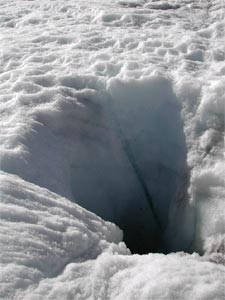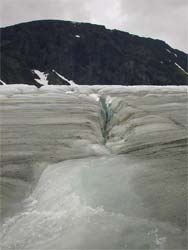About the Project
 Glaciers melt. These days, glaciers are melting a lot. An area of research in glaciology concerns how melting water from glaciers affects the glacier that it comes from. During the summer months melting increases and rushes over, into, through, and beneath the glacier. One result of all this melt water is that once it arrives at the bed beneath the glacier, the hydrostatic pressure that builds between the bottom of the glacier and the underlying bedrock helps increase the down-valley movement of the glacier. This happens because the hydrostatic pressure reduces the contact friction between the bottom of the glacier and the rock that it typically sits on. In essence, the water at the bed ‘floats’ the glacier so that it can slide more easily down the valley under the influence of gravity.
Glaciers melt. These days, glaciers are melting a lot. An area of research in glaciology concerns how melting water from glaciers affects the glacier that it comes from. During the summer months melting increases and rushes over, into, through, and beneath the glacier. One result of all this melt water is that once it arrives at the bed beneath the glacier, the hydrostatic pressure that builds between the bottom of the glacier and the underlying bedrock helps increase the down-valley movement of the glacier. This happens because the hydrostatic pressure reduces the contact friction between the bottom of the glacier and the rock that it typically sits on. In essence, the water at the bed ‘floats’ the glacier so that it can slide more easily down the valley under the influence of gravity.
On days when lots of melting occurs, the surface of Storglaciären becomes covered with numerous small streams. This is common for temperate valley glaciers during the summer months. How does all this water get to the bottom of the glacier?
 Understanding the manner in which melt water moves from the surface of a glacier to the bottom of a glacier is the main goal of this research project. Once melted at the surface of the glacier, much of the water drains into the glacier through some type of englacial drainage passage. Do they follow some type of pre-existing drainage pathway through the ice? Or does the meltwater drill its own passageway through the ice? What do these englacial drainage passages look like? What is their hydrodynamic connection to the bed of the glacier? How fast does water travel through them? What is their relative abundance within a glacier? We spent the past 3 summers at Storglaciären, an alpine glacier in northern Sweden doing research that would shed light on these questions.
Understanding the manner in which melt water moves from the surface of a glacier to the bottom of a glacier is the main goal of this research project. Once melted at the surface of the glacier, much of the water drains into the glacier through some type of englacial drainage passage. Do they follow some type of pre-existing drainage pathway through the ice? Or does the meltwater drill its own passageway through the ice? What do these englacial drainage passages look like? What is their hydrodynamic connection to the bed of the glacier? How fast does water travel through them? What is their relative abundance within a glacier? We spent the past 3 summers at Storglaciären, an alpine glacier in northern Sweden doing research that would shed light on these questions.
 One place where the surface meltwater on Storglaciären descends is into moulins. A moulin is a hole in the ice that has been ‘drilled’ by meltwater. The opening of this particular moulin is about 2.5 meters in diameter. While moulins are present on all temperate valley glaciers, they are not nearly numerous enough to account for all surface drainage.
One place where the surface meltwater on Storglaciären descends is into moulins. A moulin is a hole in the ice that has been ‘drilled’ by meltwater. The opening of this particular moulin is about 2.5 meters in diameter. While moulins are present on all temperate valley glaciers, they are not nearly numerous enough to account for all surface drainage.
Based on what we saw with the underwater video camera, it is our contention that most meltwater that descends into the glacier does so by crevasses. Here is a photo of water flowing from a crevasse. This crevasse is located at the margin of the glacier, which explains the emergence of water. Crevasses in the central body of the glacier likely absorb melt water, and entomb the water as they are ‘pinched’ closed by the overlying movement of the glacier, advecting as a water filled fracture into the deeper regions of the glacier. We suggest that these relict water filled crevasses interconnect to form a vast network of fractures that slowly drains water englacially to the bed.